A Detailed Look at the Physical Evidence Regarding the Break-In
By Ron Hendry
In order to convict Amanda and Raffaele, the Prosecution relied upon a convoluted theory to connect Amanda and Raffaele with Rudy in the commission of the murder. This convoluted theory hinged upon being able to almost summarily dismiss the broken and open window in Filomena Romanelli’s room as a staging of a break-in instead of an actual break-in by a known burglar by the name of Rudy Guede. A host of rationales and other supposed factors and witness observations have been put forth by the prosecution to offhandedly promote what happened to Filomena’s room and her window as being a staged event. These flimsy rationales for a staged break-in have also been promoted by Judges in their justification of a wide range of opinions adverse to Amanda and Raffaele.
The early posturing of the break-in as a staged situation without a rigorous investigation and sound factual evidence to back it up resulted in the murder investigation being turned upside down from the beginning. The threshold for proving it was other than a burglary break-in as it outwardly appeared should have been very high. Instead the threshold for proving it was a burglary break-in was set very high and seriously handicapped by the failure of the police to perform due diligence in promptly investigating and fully documenting the inside and outside areas as a break-in.
Simply put, if Rudy Guede had gained entrance to the cottage through Filomena Romanelli’s room, then Amanda Knox and Raffaele Sollecito are innocent of any involvement. Additionally they should never have been considered suspects and would never have been subjected to all they have endured for almost the past three years.
This four part analysis is intended to provide a rigorous examination of the physical evidence associated with the found condition of Filomena Romanelli’s room and window.
Part one of four - How was Filomena’s window broken?
By Ron Hendry
With the dispute over the “break-in”, the first question that comes to mind is just how was the window broken? Several police crime scene photos were reviewed of the found condition of Filomena Romanelli’s room and broken window as well as the exterior wall and grounds. Filomena Romanelli, flat mate of Meredith Kercher and Amanda Knox, had the room next to the door entrance in the four room upstairs cottage flat. The furniture in her room consisted of a twin sized bed, a nightstand, freestanding wardrobe closet, and a desk. The only outside window appeared to be nominally two feet wide by four feet high as shown in the photo below. This window was in turn comprised of two casement glass windows which swung horizontally to the inside to open and could be latched closed together. A set of dark green louvered shutters were located on the outside and a set of solid white shutters were located on the inside. Both the inside and outside shutters could also be latched closed.
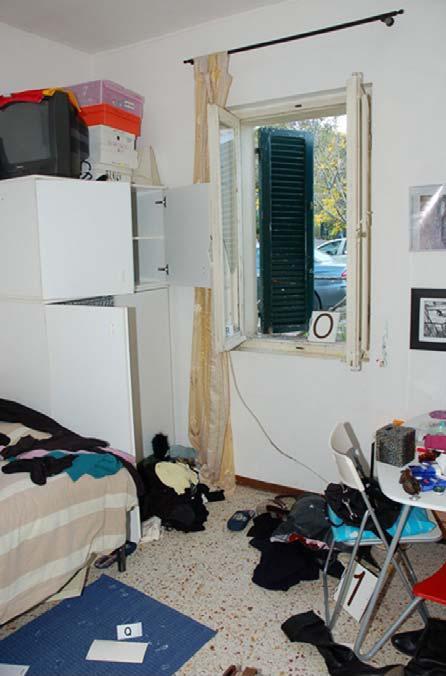
What follows is a look at the evidence relating to the broken window that can be discerned from these photos along with a couple of reported observations about where the glass pieces were and were not found.
Evidence and factors relating to the broken window
1. Large section of one casement window pane broken out
The photo below shows the broken window pane which was the left pane from the inside of the room looking out. Almost half of the nearly four foot high pane was broken out. The bottom arrow locates a recent impact site to the separable inside solid wood shutter. In order to unlock the casement windows, an intruder’s hands would need to be able to extend through the broken out pane and reach the latch at the receptacle shown at the upper arrow about 2 inches above the “S” marker.
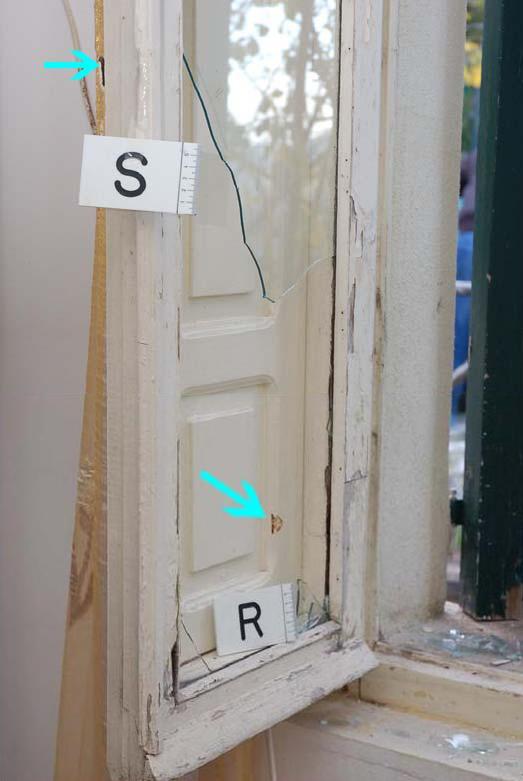
2. A large rock was found inside the room and well to one side of the broken window pane.
A large rock was found inside Filomena Romanelli’s room near the window. This rock was located to the side of the unbroken casement window pane. The rock came to rest about two feet from the wall and about one foot to the right of the window edge. This large rock had hit the top of a large paper bag full of clothing and had pushed the bag over and away from the window while also inducing a large tear in the bag. The rock was not located directly beneath the window where one would expect to find it in a staged placement.
The photo below shows the large rock found in Filomena’s room. This was a photo extracted from a video of the crime scene in Filomena’s room. Note the cluttered appearance of the room.
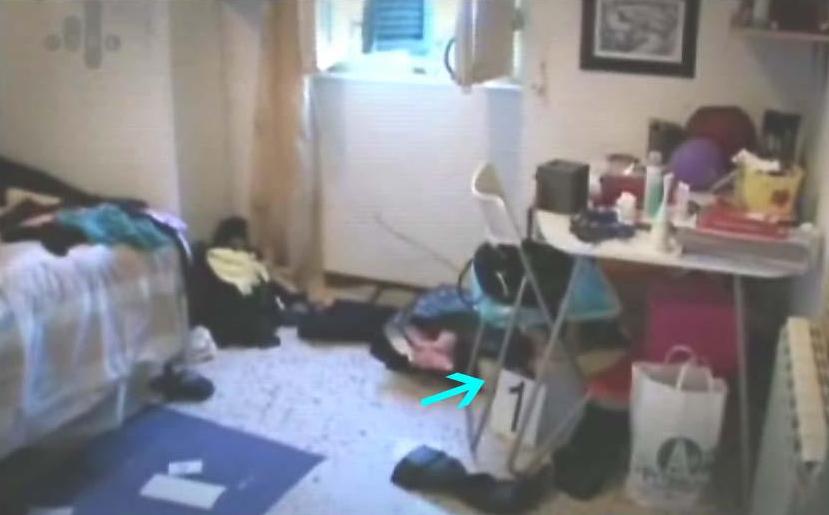
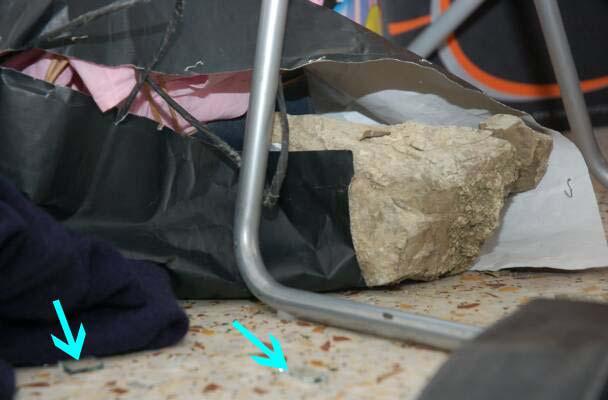
The photo below shows a close-up of the large rock and torn black paper bag. Small flakes of the rock were observed where the rock hit the floor. Also note the two small pieces of glass lying on the floor at the arrows.
3. Impact damage to inside solid wood shutter with apparent shattered glass in the impact damage zone
The photo below shows that the inside solid wood shutter was freshly impacted by an object in the locale of the impact to the broken window pane.
The red arrow points to a fresh appearing impact site at a corner edge of the inside solid wood shutter. Crushed or powdered glass appears embedded in this small impact site. Note the crush deformation line behind this impact site. The blue arrow points to a small piece of glass stuck to the inside shutter.
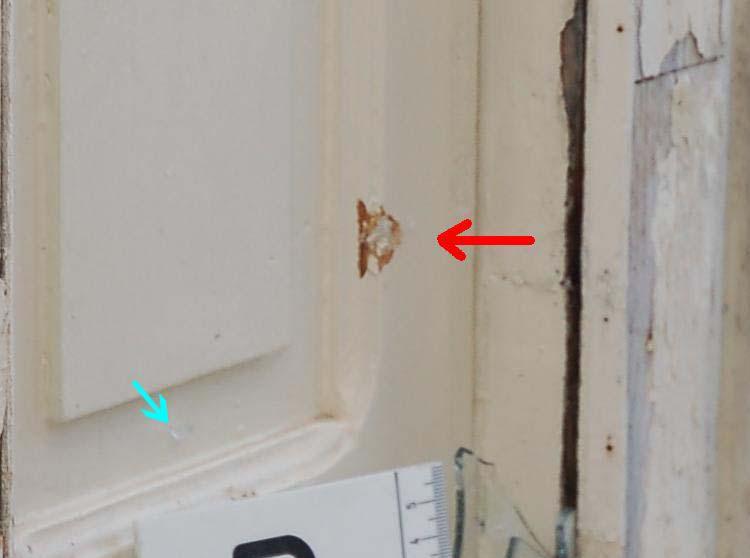
4. Found condition of outside louvered window shutters in locale of broken window pane
The photo below shows a Close-up of the lower half of the outer window shutter opposite the broken window pane. A portion of the eighth shutter from the bottom appears damaged and without paint covering. A small area of the lower left was also without paint. No embedded or stuck glass shards can be seen in the shutter nor were any reported.
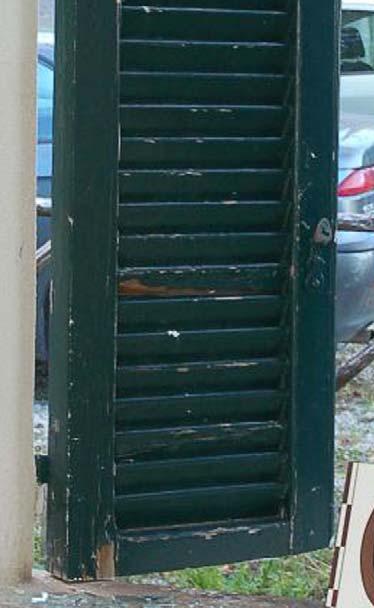
5. The location of the loose pieces of broken glass as ascertained from photos
Police photos and video still photos show that glass shards and fragments were located on the outside and inside window sill, on the floor inside the room by the window, and a wide scattering of glass pieces on the floor from the window and bed toward the desk wall. The blue mat provided excellent contrast for viewing the glass pieces while a couple of video stills captured the reflective sunlight from small glass fragments widely scattered over most of the floor.
In the photo below, the four circles denote the several locations of loose glass that can be definitively seen from early strobe light photos. The following close-ups are of the locations with exception of the glass near the resting place of the rock which has already been shown.
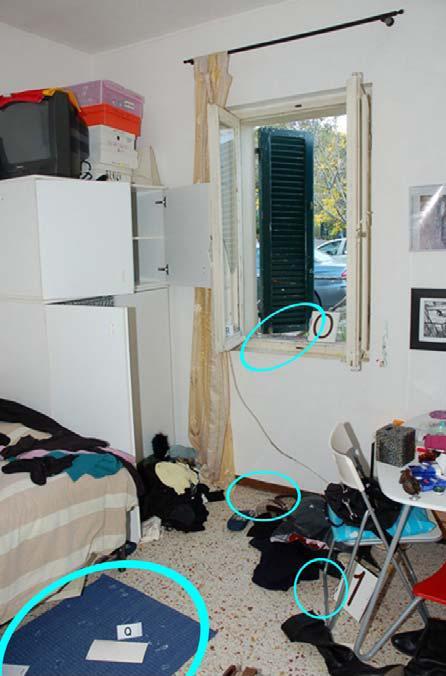
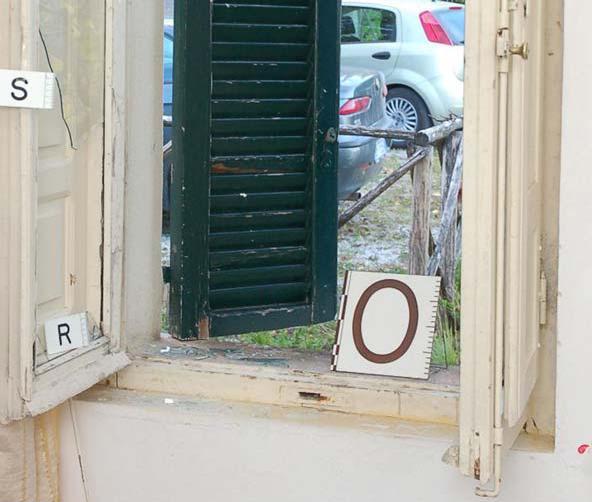
The photo below shows glass shards lying on the window sill with the shards being located only on the side where the pane was broken. Several of these shards appeared to have come from the window pane edges.
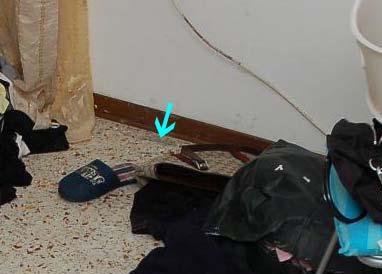
The photo below shows some glass shards on the floor under the window at the arrow. The flooring design made it very difficult to detect small glass pieces in photos taken using strobe lighting.
The photo below shows the blue floor mat. The mat appears to have good traction and a relief pattern that tended to hold glass pieces of all sizes in place after they had fallen and even walked upon. Note the widely distributed spray pattern of the glass.
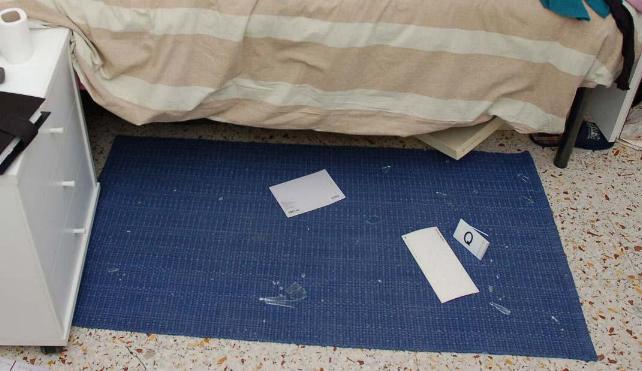
6. Reported pieces of glass found on Filomena’s clothing and belongings
Filomena Romanelli reported finding glass fragments on top of some clothing and her notebook computer and one officer reportedly observed the same thing. These observations were also touted by the prosecution as indicating the window was broken after the room was ransacked and thus meaning that the break-in was staged.
However the police photos available do not show glass particles on top of clothing or other objects. The glass particles that can be seen in the photos are on the floor and blue floor mat.
Filomena indicated she had stored her notebook computer upright on the floor and found it lying on its side. When she went to pick it up, she noted glass pieces on it.
The photo below shows a view inside room showing heavy clutter.
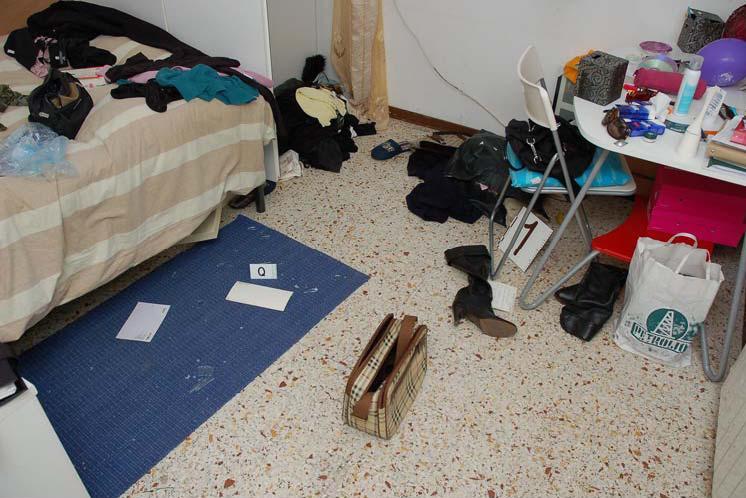
The photo below shows a bundle of clothing items on floor next to wardrobe closet. Note the pair of houseshoes.
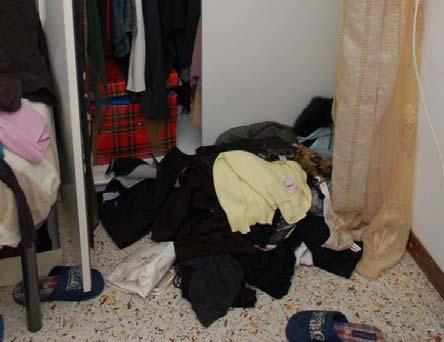
The photo below shows a closer view of desk area and items on floor around it. First note the clutter of items on top of the desk and how none appear jostled around even the upright tubes of cream or other substances. Note the pair of women’s boots in the foreground and the white bag under the desk along with the pink boxes on the shelf under the desk. Note the items on the floor towards the window to the left of the chair.
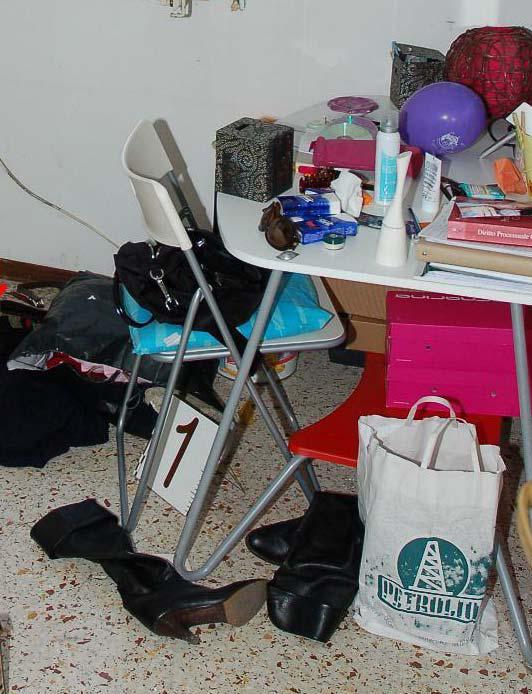
The photo below shows a closeup of the overturned black paper sack of belongings with the rock sticking halfway out. Note the dark sweater under the black paper sack. Note the light colored handbag between the wall and the black paper sack and note the black carrying bag under the handbag.
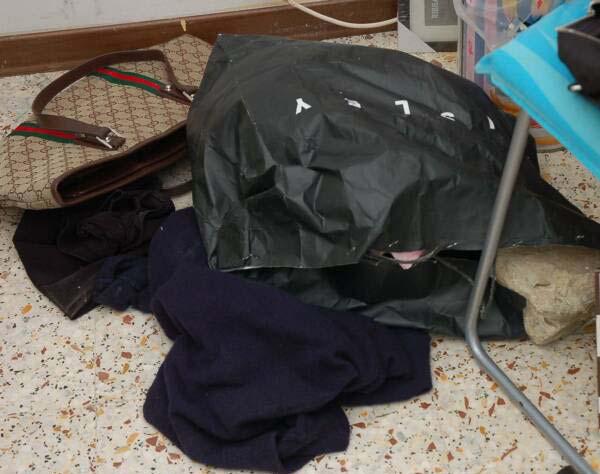
7. Reported lack of found glass pieces found on ground outside of window
Photos of the ground outside and beneath the window indicate it was a combination of earth and sod with a light coating of recently dropped autumn tree leaves. Apparently two or more persons looked at this ground area and detected no shattered glass pieces. Unless a meticulous and rigorous foot by foot examination was made of the ground area where one looks under the fallen leaves, then one would not know for sure if no glass had fallen.
The photo below is a video screen capture photo of someone possibly a police officer looking down in the vicinity of the ground outside of Filomena’s window. This video appeared to have been taken the afternoon of the discovery of the body of Meredith Kercher.
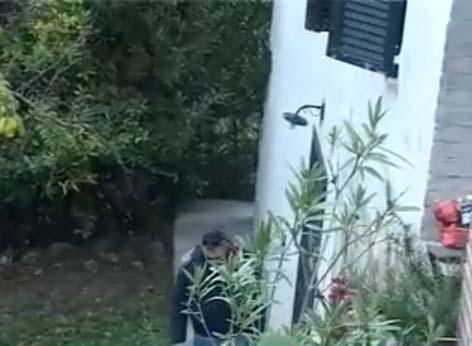
The photo below shows a view looking at the ground under Filomena’s window from a position on the ground to the left of the window and toward the walkway entrance. This photo shows the open space between the parking lot and the door entrance overhang. Filomena’s window is at the top of photo and shows open shutters. Note the yellow leaves in foreground.
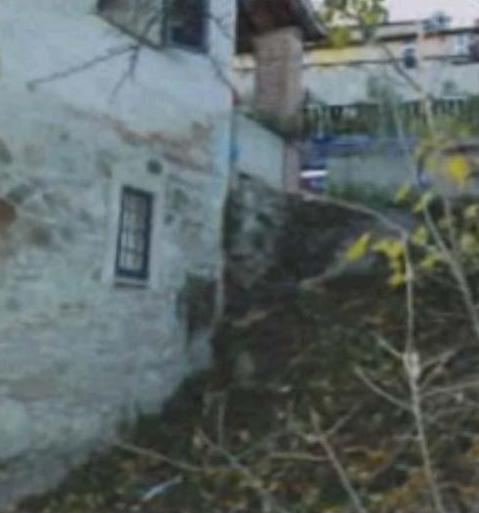
The photo below shows another view looking at the ground under Filomena’s window from the entrance walkway. Note the light blanket of recently fallen tree leaves. Note how the concrete walkway around the cottage ends at the junction of the new section with the original cottage building. Note open window shutters to Filomena’s window.
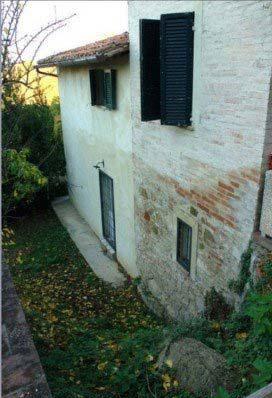
Discussion and analysis
The casement window pane was broken with most of its lower half missing and a large rock was found inside the room. The large rock had fallen onto, overturned and torn a paper bag of clothing as it fell. In landing, small pieces of the rock flaked off as a marker for where it landed. A couple of small pieces of glass could be seen near the resting position of the large rock.
Also the inside wooden shutter had a recent impact site consistent only with being impacted by an object which had initially impacted the window pane. Then too a spray of glass was found on the high contrasting blue floor mat located several feet from the window. Additional glass shards were found on the inner and outer window sill and on the floor beneath the broken window pane. Small piles of glass shards were found on the inner and outer window sill and on the floor beneath the broken window pane. Most importantly, a widely disbursed spray of glass was found on the floor from the window and bed to the desk wall.
All the above elements indicate the window pane was broken by a large rock thrown from the outside.
The final resting position of the rock indicated that the person throwing the rock was located somewhat to the driveway entrance side instead of directly in front of the window. The small contact zone to the inside wooden shutter relative to the size of the rock inferred that the shutter was partially open when impacted by the large rock.
Any theory that promotes the window being broken from the inside totally falls apart when attempting to account for the spray of broken window pieces on the floor which was best illustrated on the high contrasting blue floor mat next to Filomena’s bed
If the window was closed when impacted from the inside, one would not expect a spray of glass out into the room or onto the blue floor mat.
If the window was opened about halfway when impacted, one would expect any glass spray to be directed toward the wardrobe closet and not out into the opposite side of the room where it was actually found. Additionally one would not expect to see the accumulation of large glass shards on the outer window sill as they were found. Also one would expect that the simulator would have dropped the rock under the window instead of off to one side as it was actually found.
Any and all theories for the rock being thrown from the inside are unrealistic when considering both the spray of glass on the floor and the recent impact to the inner wooden shutter.
As regards the glass on items inside the room, Filomena had far too many items of clothing and belongings for the meager storage in the room and had no choice but to stack it along the walls and elsewhere. Thus, her report of finding belongings covered with pieces of glass is consistent with a rock thrown from the outside.
As regards the areas of exposed wood to the outside shutter, these areas were old in appearance. In addition they did not look like damage one would expect to occur from an impact with a rock. Further, the louver damage area appeared to have resulted from a flaking off a portion of the wood. Had the louver damage been related to contact with the rock, then one would have expected the missing wood piece to have been found and promoted as a rock contact site.
As regards the lack of glass on the outside ground, if the rock had been thrown from the inside and struck the window pane and then the outer shutter, one would have expected a blast of glass particles striking the louvered shutters with some going through and falling to the ground and some being stuck in the louvers. We would also expect that the outer shutters would have been knocked open by the rock with a considerable amount of glass winding up on the ground along with the rock. We would also expect glass over most of the outer window sill.
However, no glass was found stuck in the louvers, the glass was restricted to one side of the window sill, the rock was found in the room, and no glass was found on the ground.
Thus, the found condition of the outside louver, the location of the glass on the window sill, and lack of finding of glass pieces outside on the ground were all an indication of a rock thrown from the outside rather than from the inside.
Actually one would also expect a few small pieces of glass to fall to the ground with a rock thrown from the outside. It is likely that no one conducted a rigorous foot by foot sifting of the soil for glass pieces. With the light blanket of fallen leaves, one would not easily detect a few small pieces of fallen glass.
Thus the totality of the physical evidence overwhelmingly indicates that the window pane was shattered by a large rock thrown from the outside and that large rock was the one found inside the room. While this is a strong indicator of an intruder’s handiwork, it does not conclusively prove in and of itself that an intruder by the name of Rudy Guede actually entered the upstairs flat through the window. Part Two will explore facts relevant to that question.
The photo below shows the inside of Filomena’s room showing broken and open window, open doors of wardrobe closet, and several items of belongings on the floor. The window pane with the broken out lower portion can be seen. Also note the blue floor mat showing glass pieces and the belongings on the bed. A large rock is located just to other side of the large placard
“1” under the chair in the photo.
The photo below is a video still showing sunlight reflections of the widely scattered glass fragments on the floor from the desk wall to the bed.

Injustice in Perugia
a website detailing the wrongful conviction of Amanda Knox & Raffaele Sollecito

Professional Opinion From Forensic Engineer Ron Hendry
Additional Resources
Professional Analysis
Injustice in Perugia
The Appeal
The Victim
Meredith's Killer
Wrongfully Convicted
About Us/Contact Us
Update September, 2013: Click here to see a video of a man climbing the wall to reach Filomena's window